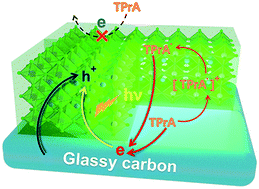Unveiling the interfacial electrochemiluminescence behavior of lead halide perovskite nanocrystals†
Abstract
In this study, a three-phase heterostructure interface including glassy carbon (conducting medium), CsPbBr3 perovskite nanocrystals (PNCs, emitter) and acetonitrile (electrolyte) is constructed for fully investigating the interfacial electrochemiluminescence (ECL) behavior of CsPbBr3 PNCs. We find that these interfaces serve as bridges for efficient electron–hole transfer during the ECL process. As a proof of concept, the increase of the heterostructure interface area will accordingly enhance the ECL intensity of CsPbBr3 PNCs. About seven-fold enhancement of the ECL intensity could be achieved when the interface area has triple-fold increase, which provides a new perspective to construct more efficient ECL systems via interface engineering.



 Please wait while we load your content...
Please wait while we load your content...